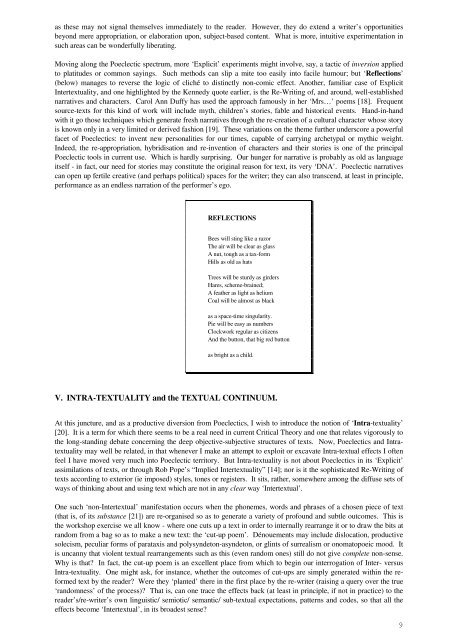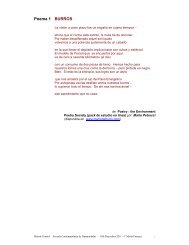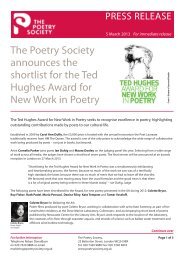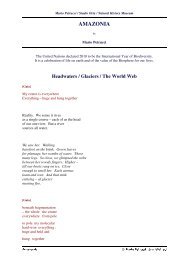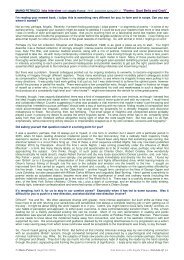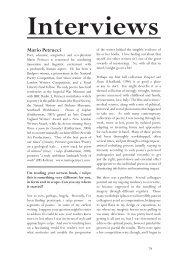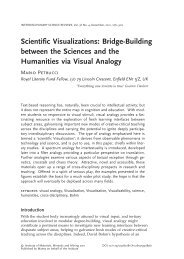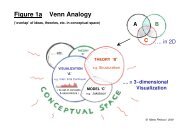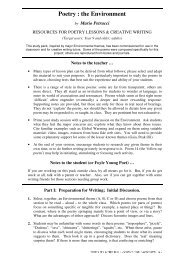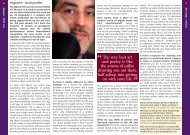poetry in performance: intertextuality, intra-textuality ... - Mario Petrucci
poetry in performance: intertextuality, intra-textuality ... - Mario Petrucci
poetry in performance: intertextuality, intra-textuality ... - Mario Petrucci
You also want an ePaper? Increase the reach of your titles
YUMPU automatically turns print PDFs into web optimized ePapers that Google loves.
as these may not signal themselves immediately to the reader. However, they do extend a writer’s opportunities<br />
beyond mere appropriation, or elaboration upon, subject-based content. What is more, <strong>in</strong>tuitive experimentation <strong>in</strong><br />
such areas can be wonderfully liberat<strong>in</strong>g.<br />
Mov<strong>in</strong>g along the Poeclectic spectrum, more ‘Explicit’ experiments might <strong>in</strong>volve, say, a tactic of <strong>in</strong>version applied<br />
to platitudes or common say<strong>in</strong>gs. Such methods can slip a mite too easily <strong>in</strong>to facile humour; but ‘Reflections’<br />
(below) manages to reverse the logic of cliché to dist<strong>in</strong>ctly non-comic effect. Another, familiar case of Explicit<br />
Inter<strong>textuality</strong>, and one highlighted by the Kennedy quote earlier, is the Re-Writ<strong>in</strong>g of, and around, well-established<br />
narratives and characters. Carol Ann Duffy has used the approach famously <strong>in</strong> her ‘Mrs…’ poems [18]. Frequent<br />
source-texts for this k<strong>in</strong>d of work will <strong>in</strong>clude myth, children’s stories, fable and historical events. Hand-<strong>in</strong>-hand<br />
with it go those techniques which generate fresh narratives through the re-creation of a cultural character whose story<br />
is known only <strong>in</strong> a very limited or derived fashion [19]. These variations on the theme further underscore a powerful<br />
facet of Poeclectics: to <strong>in</strong>vent new personalities for our times, capable of carry<strong>in</strong>g archetypal or mythic weight.<br />
Indeed, the re-appropriation, hybridisation and re-<strong>in</strong>vention of characters and their stories is one of the pr<strong>in</strong>cipal<br />
Poeclectic tools <strong>in</strong> current use. Which is hardly surpris<strong>in</strong>g. Our hunger for narrative is probably as old as language<br />
itself - <strong>in</strong> fact, our need for stories may constitute the orig<strong>in</strong>al reason for text, its very ‘DNA’. Poeclectic narratives<br />
can open up fertile creative (and perhaps political) spaces for the writer; they can also transcend, at least <strong>in</strong> pr<strong>in</strong>ciple,<br />
<strong>performance</strong> as an endless narration of the performer’s ego.<br />
REFLECTIONS<br />
Bees will st<strong>in</strong>g like a razor<br />
The air will be clear as glass<br />
A nut, tough as a tax-form<br />
Hills as old as hats<br />
Trees will be sturdy as girders<br />
Hares, scheme-bra<strong>in</strong>ed;<br />
A feather as light as helium<br />
Coal will be almost as black<br />
as a space-time s<strong>in</strong>gularity.<br />
Pie will be easy as numbers<br />
Clockwork regular as citizens<br />
And the button, that big red button<br />
as bright as a child.<br />
V. INTRA-TEXTUALITY and the TEXTUAL CONTINUUM.<br />
At this juncture, and as a productive diversion from Poeclectics, I wish to <strong>in</strong>troduce the notion of ‘Intra-<strong>textuality</strong>’<br />
[20]. It is a term for which there seems to be a real need <strong>in</strong> current Critical Theory and one that relates vigorously to<br />
the long-stand<strong>in</strong>g debate concern<strong>in</strong>g the deep objective-subjective structures of texts. Now, Poeclectics and Intra<strong>textuality</strong><br />
may well be related, <strong>in</strong> that whenever I make an attempt to exploit or excavate Intra-textual effects I often<br />
feel I have moved very much <strong>in</strong>to Poeclectic territory. But Intra-<strong>textuality</strong> is not about Poeclectics <strong>in</strong> its ‘Explicit’<br />
assimilations of texts, or through Rob Pope’s “Implied Inter<strong>textuality</strong>” [14]; nor is it the sophisticated Re-Writ<strong>in</strong>g of<br />
texts accord<strong>in</strong>g to exterior (ie imposed) styles, tones or registers. It sits, rather, somewhere among the diffuse sets of<br />
ways of th<strong>in</strong>k<strong>in</strong>g about and us<strong>in</strong>g text which are not <strong>in</strong> any clear way ‘Intertextual’.<br />
One such ‘non-Intertextual’ manifestation occurs when the phonemes, words and phrases of a chosen piece of text<br />
(that is, of its substance [21]) are re-organised so as to generate a variety of profound and subtle outcomes. This is<br />
the workshop exercise we all know - where one cuts up a text <strong>in</strong> order to <strong>in</strong>ternally rearrange it or to draw the bits at<br />
random from a bag so as to make a new text: the ‘cut-up poem’. Dénouements may <strong>in</strong>clude dislocation, productive<br />
solecism, peculiar forms of parataxis and polysyndeton-asyndeton, or gl<strong>in</strong>ts of surrealism or onomatopoeic mood. It<br />
is uncanny that violent textual rearrangements such as this (even random ones) still do not give complete non-sense.<br />
Why is that? In fact, the cut-up poem is an excellent place from which to beg<strong>in</strong> our <strong>in</strong>terrogation of Inter- versus<br />
Intra-<strong>textuality</strong>. One might ask, for <strong>in</strong>stance, whether the outcomes of cut-ups are simply generated with<strong>in</strong> the reformed<br />
text by the reader? Were they ‘planted’ there <strong>in</strong> the first place by the re-writer (rais<strong>in</strong>g a query over the true<br />
‘randomness’ of the process)? That is, can one trace the effects back (at least <strong>in</strong> pr<strong>in</strong>ciple, if not <strong>in</strong> practice) to the<br />
reader’s/re-writer’s own l<strong>in</strong>guistic/ semiotic/ semantic/ sub-textual expectations, patterns and codes, so that all the<br />
effects become ‘Intertextual’, <strong>in</strong> its broadest sense?<br />
9


